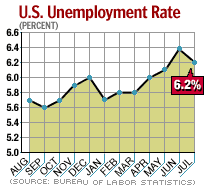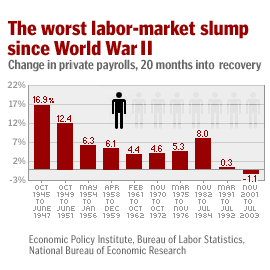NEW YORK (CNN/Money) - Regardless of the numbers that turn up in Friday's report on the state of the U.S. labor market, the core story will almost certainly be that the job market is still in limbo, neither producing nor erasing many jobs.
The Labor Department is scheduled to report the August unemployment rate and level of non-farm payrolls Friday morning. According to a Reuters poll, economists, on average, think unemployment held steady at 6.2 percent and that employers added 12,000 jobs to payrolls after cutting 44,000 in July.

But some economists might be rethinking their expectations of payroll growth, thanks to the news from the Labor Department Thursday that the four-week moving average of weekly claims for unemployment benefits crept above 400,000 -- a level that indicates jobs are still being cut.
"We're talking about the difference between a little below and a little above, but the number is consistent with the view that we're going to see payrolls flat to lower in August," said Gerald Cohen, senior economist at Merrill Lynch, which expects a loss of 10,000 jobs in Friday's report.
"But whether payrolls come in at minus 10,000 or plus 10,000, it won't tell you that much," Cohen added.
For one thing, the payroll report -- which is generated by a business survey, separate from the "household" survey that produces the unemployment number -- is fairly volatile, often subject to big revisions from month to month.
And not only is a gain of 10,000 jobs statistically insignificant -- compared with the 130 million or so total jobs on non-farm payrolls -- but such a small gain would hardly make a dent in the significant job deficit the market is already running.
A 'long, slow climb'
Payrolls are still 2.7 million jobs thinner than they were when the economy entered a recession in March 2001, the longest period without job growth since World War II.

Labor-market woes have lingered despite the fact that the recession ended in November 2001, according to the gurus at the National Bureau of Economic Research, and the economy has grown more or less steadily since then.
In fact, though enthusiastic economists see signs that the economy is set to post skyrocketing gross domestic product (GDP) growth in the third quarter, they still doubt payrolls will grow very fast or that the unemployment rate will fall much any time soon.
"The labor market's going to have a long, slow climb," said Ethan Harris, chief economist at Lehman Brothers, which expects payrolls to add 20,000 jobs in August. "Corporate America is going to use whatever means it can to boost output without hiring. They're going to wait and wait for confirmation that growth is really picking up before they move into serious job hiring."
That's the typical recession/recovery story, which is why unemployment is a lagging indicator; it usually doesn't improve until long after the overall economy has improved.
| Related stories
|

|
|
|
|
But the labor market has been much slower to recover than usual after the 2001 and the 1990-91 recessions. That fact led economists at the New York Federal Reserve to note last week that the job market's problems are more structural than cyclical, meaning that many of the jobs that have been lost are simply never coming back.
This is especially true in the manufacturing sector, which has borne the brunt of the job cuts. Technology has helped employers in that sector be more productive, milking more output out of the workers they have, and a desire to cut costs has sent many employers looking overseas for cheaper labor.
"More and more of the job losses are in industries that are effectively closing down domestically," Harris said. "This has been a gradual process since the 1950s, but it seems to have accelerated."
Hopeful signs
Still, some hopeful signs for the labor market have surfaced. Employers in the service sector, which employs about 88 percent of all U.S. workers, are slowly hiring. Weekly jobless claims aren't nearly as high as they were in the spring. Demand for temporary workers has been strong, usually a good sign of future hiring. The Help Wanted Index, published monthly by the Conference Board, a private research group, has stopped falling.
"The labor market may finally be hitting bottom," said Conference Board economist Ken Goldstein. "While layoffs remain large, they are no longer intensifying. Job advertising volume has stopped declining, although it remains at very low levels."
On the other hand, small businesses -- often the first employers to hire in a downturn -- still show little inclination to hire, according to a recent survey by the National Federation of Independent Business.
And weekly jobless claims may need to fall all the way to 357,000 before unemployment falls, according to research published this week on the Web site of Berkeley economics professor Brad DeLong -- a level that was seconded by Merrill Lynch's Cohen in an unpublished study he recently completed.
"The claims have not been low enough to merit cheering, but the direction has been generally positive, and that's the first step," Cohen said.

|

